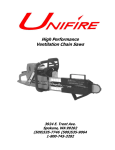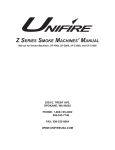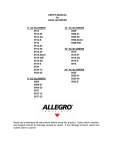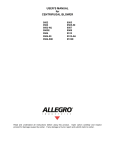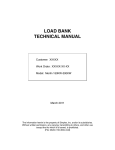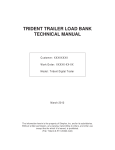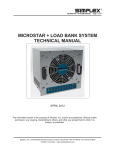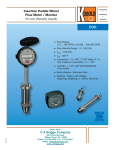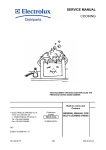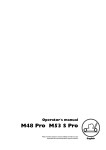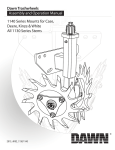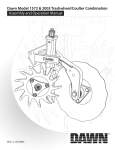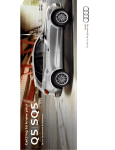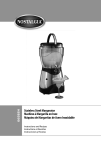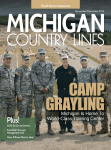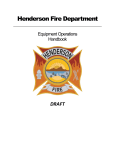Download - Unifire
Transcript
USERS MANUAL CONFINED SPACE BLOWERS Read and understand all instructions before using this product. Open carton carefully and inspect product for damage caused by carrier. If any damage is found, report and submit claim to carrier. TABLE OF CONTENTS PAGE INTRODUCTION DESCRIPTION SAFETY PRECAUTIONS WARNINGS AND LIMITATIONS OPERATION MAINTENANCE Troubleshooting STORAGE FREQUENTLY ASKED QUESTIONS WARRANTY 2 2 2-4 5 5-6 8-9 9-10 10-12 13-14 16 RETURN POLICY 16 INTRODUCTION This manual provides instructions for the use and maintenance of Unifire Confined Space Blowers. You must read and understand this manual and be trained in the proper use of the equipment before using it in a contaminated atmosphere. There are many federal, state and local codes and regulations governing sales, construction, installation and/or use of products for certain purposes, which may vary. UNIFIRE cannot be responsible for how the products are used and installed. Before purchase and use, the buyer must review the product application, and be sure that the product installation and use will comply with those regulations. For more information and assistance on Unifire products, contact Unifire Technical support toll free at 1-800-745-3282 or e-mail at: info@unifireusa.com DESCRIPTION Unifire Confined Space Blowers are designed to offer high output CFM in easy-to-use portable, airover-motor configurations. They are available in outputs from 778 up to 5500 CFM of free air. Unifire Confined Space blowers are available in a range of styles, sizes and power. Blowers are standard 115 VAC but are available in 230 volt. SAFETY PRECAUTIONS DO NOT operate blower until the operator completely comprehends the contents of this manual. The blower is a specialized type of powered equipment, designed for a specific job function and requires adequate and thorough instruction BEFORE it is operated. Each person must receive adequate professional instruction regarding proper operation. Read and understand this User Manual and the material supplied by the motor manufacturer. Refer to OSHA 2207, for job safety and health rules and regulations (1926 and 1910) covering construction. DO NOT allow minors to operate the blower. Bystanders, children and animals should not be allowed in the area where a blower is in use. DO NOT use an undersized wire size on electrical power cable or extension cords if used. This will adversely limit the starting and load carrying capabilities of the motor. Always use minimum AWG wire sizes for motor branch circuits. Consult the National Electric Code Tables, Article 400, for specific information. DO NOT operate the blower without the inlet and outlet screens properly secured and in place. Replace screens with factory replacements (OEM). The screen grid must comply with current OSHA regulations regarding protective enclosures to prevent personal injury to the operator(s). Ensure that the structural integrity of the screens will allow them to serve their protective function. Keep both screens free from obstructions and debris to allow maximum airflow. DO NOT stand directly in front of and/or face the blower outlet. Personal injury may result from debris being thrown from the blower fan at relatively high velocity. DO implement an operational safety program for this blower, to include but not limited to: instructional requirements for operation, applicable OSHA requirements, local laws and regulations, job site safety and blower maintenance. Operators must be fully instructed regarding the specifics of this safety program. (Ref. 29CFR 1926.21 (b)(2)). DO ensure that the blower is in its original, factory configuration and has not been modified. Any modifications may result in potentially dangerous configurations that can lead to property damage and/or personal injury. As well as voiding the manufacturer’s warranty. DO ensure that operator(s) are in adequate physical condition, mental health and not under the influence of any substance (drugs, alcohol, etc.) which might impair vision, dexterity or judgment. If you have any condition that might be aggravated by strenuous work, check with your doctor before operating the blower. Guard against the possibility of back related injuries. Always use proper lifting techniques when moving or carrying blower. DO wear sturdy and snug fitting clothing. Never wear loose fitting clothing or anything that could become caught on controls or moving parts. Wear long pants to protect your legs. To improve your grip and protect your hands, wear heavy duty, non-slip gloves. Wear steel-toed safety boots with non-slip soles. Sneakers or other similar type shoes do not provide adequate protection. DO wear an approved safety hard hat. Noise, generated by the blower, may damage your hearing. Wear sound barriers (ear plugs or ear mufflers). Continuous and regular operators should have their hearing checked regularly. DO a visual inspection of the blower and check for damaged, worn, loose and/or broken parts. Ensure that all safety devices are operable and information decals are readable. Check to see that the blower and all related accessories are in good mechanical condition before use. DO verify that the blower uses appropriate electrical cord and NEMA plug. Electrically driven blowers are designed to operate ONLY from a grounded 115 volt AC, 60Hz or 220V/50Hz, single-phase power source. Select models are available with 220V/50Hz. All electrical wiring installations and connections must comply with all applicable NEC statutes and with all applicable local codes and practices. (Consult current National Electric Code publications for specific information.) DO ground the blower motor securely. Ensure that the “grounding” wire and/or device is properly grounding the motor. Failure to properly ground the motor may cause an electrical shock and/or electrocution, resulting in personal injury or even death. DO use a ground fault circuit interrupter (GFCI). A GFCI is a safety device that disconnects power from a circuit to a load when a potentially dangerous condition occurs. The GFCI acts like a fastacting fuse or circuit breaker, sensing small imbalances in the circuit caused by current leakage, and shutting off electricity within 25mS (milliseconds). Use of a portable GFCI gives on-the-job protection from electrical shock hazards caused by ground faults in commercial, industrial and residential applications. (For specific information, consult the NEC publications and OSHA publications 210-22D for construction sites and 555-3 for marina’s or for use around any area containing water.) DO know where the controls are, how they operate, and how to stop the blower in an emergency. DO verify the location classification. Certain job site locations may be classified as hazardous because of explosive concentrations of gas, vapor or dust in the atmosphere. The National Electric Code divides these locations into Classes and Groups according to the type of explosive agent. For specific information, consult the NEC, Section 500. Use Unifire Explosion-Proof Blowers for operation in an explosive or flammable atmosphere. The use of any other blower not designed for use in a Hazardous Location may result in personal injury or death. DO place the blower on secure footing to prevent it from shifting while in use. Such movement can cause injury to the operator(s) or damage to the blower itself. DO ensure blower is operated in a horizontal position to meet the enclosure definition. The blower is designed for operation in job site areas that are reasonably dry, clean and provide for a continuous, dynamic source of air for cooling the motor. Any questions about operating environments, contact the Unifire Technical Support at 1-800-745-3282, or e-mail at info@unifireusa.com, before using the blower. WARNINGS AND LIMITATIONS Flow rate testing was performed by the Colorado Engineering Experiment Station, Inc. The Blowers were tested per AT&T Standard EL2723/PL2709 in a chamber built in accordance with AMICA Standard 210-67. The test was performed with a single, 8-inch (203mm) diameter x 15 feet (7.6m) flexible, reinforced duct connected to the blower outlet. The published flow rates are intended to serve only as a reference. Manufacturing tolerances and specific operating parameters will affect the overall flow rate(s) for each particular blower. Actual flow rate will decrease when the total length of the ducting is increased more than 15 feet (7.6m). Actual flow rates may change if blower is used with ducts manufactured and/or supplied by other sources. CAUTION! The final working procedure for any job application involving the use of the blower must be individually determined after careful analysis of all factors and/or conditions present. The nearest OSHA office is a valuable source for applicable information regarding the operation of the blower. CAUTION! Before using the blower, check all applicable federal, state, industry and local regulations regarding the use of flame resistant and/or self extinguishing duct materials for the intended job applications. It is the responsibility of the owner(s) and/or operator(s) to determine that the duct material in use for the job application meets all applicable fire code and OSHA requirements DANGER! Always stop the motor and disconnect the power source to prevent accidental starting and/or the possibility of receiving an electrical shock. DANGER! Never enter a manhole or confined work area, until it has been determined to be safe for entry and tested with appropriate gas detection equipment and ventilated for a minimum of five (5) minutes with the blower at maximum speed. OPERATION Use of Duct: 1. Operate the blower upwind from the work location and with the air inlet facing into the relative wind to maximize airflow. 2. The Unifire flexible ducts are for use with Unifire blowers. a. All are of the collapsible, reinforced design. b. Each duct is supplied with a nylon strap to secure each end to the blower and or a duct connector. c. When using statically conductive ducting, the integrated grounding wire must be properly: Grounded to the blower chassis. Linked to any additional grounding wire or duct used. 3. It is recommended that the total length of duct does not exceed 100 feet. 4. To join two sections of duct, use a duct-to-duct connector. 5. Pull duct sleeve over the outlet port at least six (6) inches and secure the duct to the blower with the nylon-clamping strap and tighten securely. 6. For exhaust (air blowing) operations, connect the duct to the blower outlet. a. The duct can be one of two types: Collapsible, non-reinforced. i. Collapsible, flexible, reinforced. 7. For extraction (air evacuation) operations, connect the duct to the blower inlet. a. The duct must be of the reinforced type to prevent the vacuum force generated by the blower’s suction from collapsing the duct. b. For the Com-Pax-ial and 12” Axial blowers, duct can be secured on either side of blower. c. For the 8” Axial blowers an optional inlet adapter (P/N: 9500-03) must be used Remove the inlet grill. i. Attach the inlet adapter and secure. d. For the 16” Standard and 16” Explosion Proof Axial blower. Remove the ring flange from the exhaust and relocate to the inlet side and i. secure. You may purchase an additional ring flange for dual extraction/ventilation use. Part No’s needed are: • 9515-03R Ring adapter 1ea • 9800-68 Machine screw3ea • 9500-63 Washer 3ea DANGER! Before using the blower, check all applicable federal, state, industry and local regulations regarding the use of flame resistant and/or self extinguishing duct materials for the intended job applications. It is the responsibility of the owner(s) and/or operator(s) to determine that the duct material in use for the job application meets all applicable fire code and OSHA requirements. OPERATION Voltage and Power Selection: 1. The voltage, frequency and phase of the power supply must be consistent with the motor nameplate rating. a. The motor will operate satisfactorily on voltages within 10% of the nameplate value or frequency within 5%. The combined variation must not exceed 10%. 2. The Unifire blowers are designed to operate from a grounded, 115 VAC, 60Hz or 220V/50Hz, single-phase power source. a. Select models are available in a 220V/50Hz. single-phase configuration. b. It is crucial to the performance of the blower that the proper power source is selected. 3. Select blowers are supplied with a standard P5-15 plug or a twist-lock NEMA plug (excluding 220V/50Hz blowers) a. Do not change or alter the plug, as this will affect the performance of the blower. b. Operation from an inadequate power source or use of incorrect electrical plug may result in property damage and/or personal injury. 4. To determine maximum length of extension cord, when used with a blower, refer to the National Electric Code Tables, Article 400. MAINTENANCE Maintenance & Repair: • Use only genuine Unifire approved, replacement parts for maintenance and repair. Use of parts manufactured by others can result in property damage and/or personal injury. • Follow the service instructions as outlined in the Maintenance section of this Users Manual. • Always properly maintain the blower. Frequently check all fasteners and individual parts. Builtin safety features are effective only if they are maintained in good working condition. Keep the blower clean and properly serviced. Heavy accumulations of dust and dirt will result in overheating and premature failure of the blower motor. Clean the motor surfaces and all ventilation openings periodically. • Always stop the motor and disconnect the power source to prevent the accidental starting and/or the possibility of receiving an electrical shock working on the blower. • Do not energize the electric motor with the shaft key exposed on the open shaft. Personal injury can result from being struck by a shaft key thrown from the motor shaft. DANGER! Always stop the motor and disconnect the power source to prevent the accidental starting and/or the possibility of receiving an electrical shock. ** Do not attempt any maintenance or repair work not described in this Product Manual ** Electric Motor Maintenance: • The electric motor is capable of operating for many years with minimum maintenance. • Before attempting to service the motor, disconnect the blower from the power supply. • Clean the motor surfaces and ventilation openings periodically, preferably with a vacuum cleaner. Heavy accumulation of dirt and lint will result in overheating and premature failure of the motor. • The electric motor is equipped with ball bearings, and under normal service and ambient temperatures should not require re-lubrication for 9 to 10 years. If you feel that the motor requires re-lubrication, contact the local service representative of the motor manufacturer for specific information. TROUBLESHOOTING Electric Motor: TROUBLE CAUSE WHAT TO DO Blown Fuses Improper current supply Improper line connections Motor Fails to Start Open circuit in winding or starting switch Mechanical failure Short circuited stator Motor may be overloaded Defective capacitor Motor Stalls Overloaded motor Low motor voltage Open circuit Motor runs and then dies Motor does not come up to speed Motor takes too long to accelerate Wrong rotation Motor overheats while running under load Motor vibrates after corrections have been made Scraping noise Noisy operation Power failure Replace fuses at least 125 % of nameplate amperes. Ensure that the power supplied agrees with motor nameplate and load factor. Check connections with diagram supplied with motor. Indicated by humming sound when switch is closed. Repulsion induction motors may spark at brushes. Check for loose wiring connections; also see if starting switch inside motor is closed. Ensure that motor and drive turn freely. Check bearings and lubrication. Indicated by blown fuses. Motor must be rewound. Reduce load. Check for short circuit, grounded or open capacitor, replace if necessary. Reduce load. See that nameplate voltage is maintained. Fuses blown, check overload, relay, stator and resetbuttons. Check for loose connections to line, to fuses and to control. Open primary circuit Locate fault with testing device and repair. Excess loading Poor circuit Applied voltage too low Wrong sequence of phases Overload Dirt build-up, insufficient ventilation. May have one phase open Unbalanced terminal voltage Shorted stator coil Faulty connection High voltage Low voltage Motor misaligned Reduce load. Check for high resistance. Get power company to increase power tap. Reverse connections at motor. Reduce load Weak foundations Strengthen (tighten) base. Fan rubbing Fan striking housing insulation Rotor or fan wheel unbalance Remove or clear interference. Clean Ensure that all leads are well connected. Check for faulty leads, connections. Repair and then check wattmeter reading. Indicated by high resistance. Check terminals of motor with a voltmeter. Check terminals of motor with voltmeter. Realign. Clear fan. Rebalance. STORAGE The proper procedure for long-term storage of the blower will protect it against the effects of corrosion and damage. If the blower is not to be operated for a period of 30 days or more, proceed to store as follows: 1. Clean all accumulated dirt and grease from the blower using an appropriate cleaner. 2. Check parts for wear or damage. Make the necessary repairs. 3. Apply a light coat of dry film lubricant to the blower hub and shaft to prevent rust formation. 4. Store the blower indoors. If the blower must be stored outdoors, protect it from the elements with a suitable enclosure or storage. CONFINED SPACE APPLICATIONS DANGER! Refer to local and federal OSHA Confined Space Laws and Regulations. CAUTION! The final working procedure for any job application involving the use of the blower must be individually determined after careful analysis of all factors and/or conditions present. The nearest OSHA office is a valuable source for applicable information regarding the field use of the blower. Hazardous Location Requirements: • All Explosion Proof Blowers must be used with the Hazardous Location Plug and Socket, • Only statically Conductive Ducting may be used with Explosion Proof Blowers. • The Unifire Explosion proof blowers are rated to be used in the following hazardous locations: • Verify your location classification. Blower Class Division Group 9513-05 I I &II C&D 9514-05 9514-06 II I & II E, F & G 9509-01 9515-01 I I & II E, F, & G II I & II F&G • Ensure the blower design meets the hazardous class and group classifications of job site. • The National Electric Code divides these locations into Classes and Groups according to the type of explosive gas/agent, which may be present. • For specific information on Hazardous Location requirements, consult the National Electric Code, Section 500 through 517, or a qualified electrician. • The Hazardous Location plug and receptacle must be used and properly wired using a conduit system to the power source. CAUTION! Hazardous location equipment may be required in any area where the presence of flammable gases, vapors or finely pulverized dusts in the atmosphere is sufficient to create a threat of explosion or fire. It may also be required where easily ignitable fibers of flyings are present. CLASS I (NEC 500-5) Those areas in which flammable gases or vapors may be present in the air in sufficient quantities to be explosive or ignitable. DIVISION I (NEC 800-5, 6, 7) In the normal situation, hazard would be expected to be present in everyday production operations or during frequent repair and maintenance activity. TYPICAL CLASS I LOCATIONS Petroleum refineries, gasoline storage and dispensing areas. Industrial firms that use flammable liquids in dip tanks for parts cleaning or other operations. Petrochemical companies that manufacture chemicals from gas and oil. Dry-cleaning plants where vapors from cleaning fluids can be present. Companies that have spraying areas where they coat product with paint or plastics. Aircraft hangers and fuel servicing areas. Utility gas plants, and operations involving storage and handling or liquefied petroleum gas or natural gas. CLASS II (NEC 500-6) Those areas made hazardous by the presence of combustible dust. DIVISION II (NEC 500-5, 6, 7) In the abnormal situation, material is expected to be confined within closed containers or closed systems and will be present only through accidental rupture, breakage or unusual faulty operation. TYPICAL CLASS II LOCATIONS Grain elevators, flour and feed mills. Plants that manufacture use or store magnesium or aluminum powders. Plants that have chemical or metallurgical processes, producers of plastics, medicines and fireworks, etc. Producers of starch or candies. Spice-grinding plants, sugar plants, plants and cocoa plants. Coal preparation plants and other carbon-handling or processing areas. CLASS III (NEC 500-7) Those areas, in which there are easily ignitable fibers or flyings present, due to type of material being handled, stored or processed. GROUPS (NEC 500-3) The gases and vapors of Class 1 locations are broken into four groups by the code: A, B, C, and D. These materials are grouped according to the ignition temperature of the substance, its explosion pressure and other flammable characteristics. The dust locations of Class II are designated E, F, and G. These groups are classified according to the ignition temperature and the conductivity of the hazardous substance. NOTE: For detailed group descriptions, refer to NEC 500-3. TYPICAL CLASS III LOCATIONS Textile mills, cotton gins, cottonseed mills and flax processing plants. Any plant that shapes pulverizes or cuts wood and creates sawdust or flyings. WARNING! Explosion-proof blowers MUST BE used with statically conductive ducting. FREQUENTLY ASKED QUESTIONS Q: What is the main difference between the Axial and the Centrifugal blowers? A: The Centrifugal Blowers have the motor on the outside of the housing. The centrifugal design allows them to push against greater dynamic back-pressure (higher static pressure), leading to higher CFM with extended lengths of ducting compared to axial blowers. The Axial blowers have housed motors making them more compact, portable and less expensive. They offer higher CFM in a free air configuration. Q: Is it better to positively ventilate or to evacuate air? A: Any Confined Space must be positively ventilated; you may evacuate when fumes are being generated in a specific location. (E.g. welding, grinding, etc.) Q: Can you place the Explosion Proof Blower in an Explosive Atmosphere? A: Yes, however the blower should be at least five feet away from the entrance, in order to bring fresh air in and not just to recirculate the contaminated air. (It is recommended that the area is monitored) Q: Why do I need the explosion-proof socket and plug with the explosion-proof blower? A: The receptacle included with your blower must be hard-wired to your power source (e.g. conduit, flexible conduit) to meet explosion-proof standards. If you modify any part of the blower, cord, plug, and/or receptacle, you will void the explosion-proof certification. Q: Why do I need to use statically conductive (EX) ducting with EX Blowers? EX ducting is coated with Neoprene, which resists static charge build up. It also is integrated with a grounding wire, to maintain the ground throughout your system. Q: Can I use a blower to evacuate welding fumes? A: Yes, you can have ducting directed at the working area with the blower in the extracting configuration. Q: What’s the maximum length of ducting A: No more than 100 feet. Lengths longer than that might cause the blower to stall or overheat. Q: What is the maximum temperature the ducting can withstand? A: The maximum working temperature for ducting is 150° F. Q: Can I connect two pieces of ducting together A: Yes, you can use the optional duct-to-duct connector, P/N: 9500-01 (8”) or 9600-01 (16”). Q: Can I use the 12” or 16” Blower with 8” ducting? A: Yes, use the optional Adaptor Reducer, for 9515 use P/N: 9600-50, for 9515-01 use P/N: 960050EX, for the 12” use P/N: 9509-03. It is NOT recommended for the 16” High Output blower 9516. Q: Can you draw air with all Unifire blowers? A: Yes, You can relocate the flange on the 16” Axial blowers, only recommended on the 9515 and 9515-01, not recommended for the 9516. You may install an optional inlet adapter on the 8” Axial blowers. The centrifugal blowers have an inlet and an outlet port Q: How do I choose the correct blower to ventilate an area? A: You first need to determine the total volume (cu. ft.) of the space to be ventilated. We recommend using a blower that is capable of 20 exchanges of air per hour. Q: Can I use two blowers, one to ventilate and another to extract air, in the same space? A: Yes, when used with ducting will help concentrate the exchange of fresh air in a specific area of a given space, but will not significantly increase the overall air exchange. Q: Will the blower output decrease if I add additional ducting? A: Yes, the output will decrease with any addition of ducting or addition of bends in the ducting. Q: Are the reductions in output directly related to the length in ducting? A: No, there are several variables that will affect the total output of the blower. The biggest drop in output will occur after the first addition of ducting, thereafter the reductions are smaller. The same holds true for the number of bends. Q: Why is my blower tripping the circuit breaker? A: There are two situations that can cause this: 1. You need to make sure you have proper current to your blower. a. Check your circuit breaker, it must be of appropriate amperage (load). b. Check the voltage on the panel and the blower. c. Check for condition of electrical cord and/or extension cord, as well as ext. cord gauge and length. 2. Check for proper fan operation. a. Make sure the fan is not rubbing against the housing. b. Check for foreign material build up inside housing, this might prevent fan from turning. c. Check for any rust on shaft or damaged fan blades. Q: Can I convert my AC (115V) powered blower into DC (12V) powered blower? A: No, the motors can not be used for both applications or converted. A power inverter may be used to adapt an AC powered blower (115 VAC) to your car’s battery (12 VDC) for power. Q: How do I know that your EX Blower meets the Class, Division, and Group for my hazardous confined space? A: All of our EX blowers are shipped with an approved Hazardous Location motor, socket, and receptacle. Each blower is stamped with the approved class, div. and group. They are also supplied with the appropriate anti-spark fan. WARRANTY Damage resulting from carrier handling abuse is not covered by product warranty. Protect your interest, inspect product immediately. The following warranty information is made in lieu of all other warranties expressed, implied or statutory, including but not limited to, the implied warranties of merchantability and fitness for purpose. It is in lieu of any implied warranty of merchantability, fitness for a particular purpose or other warranty of quality, except of title and against patent infringement. In the event any Unifire Industries, Inc. product is found to be defective in material, workman-ship, or not in conformance with any expressed warranty for a specific purpose, Unifire’s only obligation and your exclusive remedy shall be to repair, replace, or refund the purchase price of such parts or products upon timely notification thereof and substantiation that the product has been stored, maintained and used in accordance with Unifire’s written instructions. Maximum liability is in no case to exceed the value of the Unifire unit involved. LIMITATION OF LIABILITY Except as provided above, Unifire Industries shall not be liable or responsible for any loss or damage, whether direct, indirect, incidental, special or consequential, arising out of sale, use or misuse of Unifire Power Blowers’ products, or the user’s inability to use such products. Refer to this Users Manual for proper use. Transportation charges in all cases will be at the customer’s expense. THE REMEDIES SET FORTH HEREIN ARE EXCLUSIVE. FOR MORE INFORMATION AND ASSISTANCE ON UNIFIRE POWER BLOWERS, CONTACT UNIFIRE TECHNICAL SERVICE TOLL FREE AT 1-800-745-3282, OR E-MAIL: [email protected] RETURN POLICY NOTE: THE FOLLOWING REQUIREMENTS MUST BE FOLLOWED IN RETURNING GOODS OR PRODUCTS TO UNIFIRE INDUSTRIES: 1. UNIFIRE INDUSTRIES requires that you obtain a Return Merchandise Authorization Number (RMA#) prior to returning merchandise to us. This number can be obtained by calling Unifire Customer Service at 800-745-3282, or requesting it in writing. NOTE: Products returned to UNIFIRE without a Return Merchandise Authorization Number will not be accepted and/or processed until one is acquired. 2. Before returning the product, decontaminate and clean it to remove any hazardous materials that may have settled on the product during use. Products suspected of asbestos and/or other dangerous contamination will be refused and returned freight collect. 3. The products or components must be returned to UNIFIRE INDUSTRIES freight prepaid, with the RMA number marked clearly on the outside of the package. UM004 Axibloman.doc Rev D 09/05

















